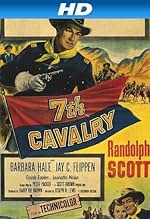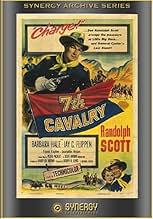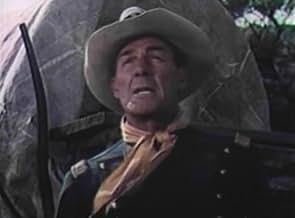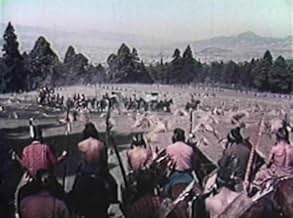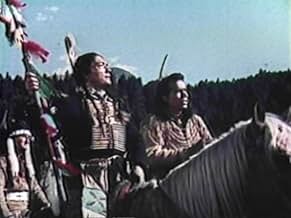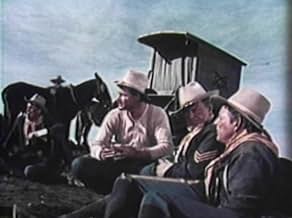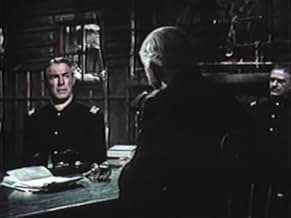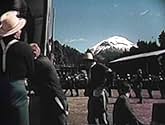NOTE IMDb
5,8/10
1,5 k
MA NOTE
Ajouter une intrigue dans votre langueAn officer accused of cowardice volunteers to bring back General Custers's body after Little Big Horn.An officer accused of cowardice volunteers to bring back General Custers's body after Little Big Horn.An officer accused of cowardice volunteers to bring back General Custers's body after Little Big Horn.
- Réalisation
- Scénario
- Casting principal
Bill Clark
- Soldier With Kellogg
- (non crédité)
Charles Horvath
- Knife-Wielding Indian
- (non crédité)
William Leslie
- Lt. Murray
- (non crédité)
Harold Miller
- Officer at Inquiry
- (non crédité)
Avis à la une
At 58, Scott was just too old for the role. Not just being only a Captain, but still in cavalry. Not realistic he would have physicality for the activity his character displays.
This scheme is for Randolph Scott what THE MAN FROM ALAMO was for Glenn Ford. Remember this Universal Studios western where Glenn Ford was accused of being a coward and escaped from Alamo slaughter? So replace Alamo by Little Big Horn, two battles that Americans lost, and you have an idea of what you deal with here. This is not my favorite from director Joseph Lewis, it could have been from André De Toth, but not from Budd Boetticher though. Because Boetticher and Lewis had their own trademark. Here, the plot, directing, camera work, are rather common, nothing to remember of. Nothing in particular, I mean. Good western not more.
Captain Benson (Randolph Scott) returns from the east with his new bride-to-be (played ably enough by Barbara Hale) only to find out that his post under General Custer was wiped out at the Battle of the Little Bighorn. The men who were left behind at the post resent Benson because he wasn't there to die gallantly with the rest of his troop.
A presidential order is given for the army to go into Sioux territory and gather up Custer's dead for burial. Benson quickly volunteers for such a dangerous mission, probably to redeem himself. After all, the Big Horn is still surrounded by hostile Sioux and Cheyenne, drunk with victory.
When Benson and his men reach the site, they find that the Indians won't let them un-bury the dead because it is now considered sacred ground and not to be violated. That is, until Custer's riderless horse strolls into view, scaring all the Indians into thinking it's bad medicine and Custer's spirit has returned.
There's a subplot about how this horse came onto the scene involving Harry Carey Jr. and all, but I'm not gonna get into that. Anyway, the Indians are plenty superstitious about the whole thing so they allow Benson and his men to pass, unscathed.
Although it's nowhere near as good as the oaters Scott did with Budd Boetticher, this one nonetheless still rises above most of the other western dreck Harry Cohn and Columbia Pictures was putting out. It also helps filming it out in the California pine country away from the usual Columbia ranch locations that we've seen a zillion times before. It still doesn't pass for the plains, though.
Still, it's better than most of Scott's RKO westerns from the late 40s
5 out of 10
A presidential order is given for the army to go into Sioux territory and gather up Custer's dead for burial. Benson quickly volunteers for such a dangerous mission, probably to redeem himself. After all, the Big Horn is still surrounded by hostile Sioux and Cheyenne, drunk with victory.
When Benson and his men reach the site, they find that the Indians won't let them un-bury the dead because it is now considered sacred ground and not to be violated. That is, until Custer's riderless horse strolls into view, scaring all the Indians into thinking it's bad medicine and Custer's spirit has returned.
There's a subplot about how this horse came onto the scene involving Harry Carey Jr. and all, but I'm not gonna get into that. Anyway, the Indians are plenty superstitious about the whole thing so they allow Benson and his men to pass, unscathed.
Although it's nowhere near as good as the oaters Scott did with Budd Boetticher, this one nonetheless still rises above most of the other western dreck Harry Cohn and Columbia Pictures was putting out. It also helps filming it out in the California pine country away from the usual Columbia ranch locations that we've seen a zillion times before. It still doesn't pass for the plains, though.
Still, it's better than most of Scott's RKO westerns from the late 40s
5 out of 10
Captain Thomas Benson returns to Fort Lincoln, the Seventh Cavalry's outpost in the Dakota wilderness, with Martha Kellogg, his bride-to-be. As the couple approach the fort, it is apparent that something is wrong. Benson enters to find the Seventh Cavalry's base strangely silent and motionless. Unknown to Benson, while he has been away General Custer has led the regiment to disaster at the Little Big Horn ...
The stillness and emptiness of the fort could serve as a metaphor for the film's lack of pace and content. The first half consists of endless breast-beating over the recent disaster, and the cavalrymen's torpid dialogue is unrelieved by motion or variety of any kind. It is fully 45 minutes before anything remotely resembling an action sequence occurs.
Benson is regarded with contempt by the remnants of the Seventh, both because he was Custer's favourite and because he managed to avoid the Little Big Horn. Matters are complicated by his choice of fiancee. Martha (Barbara Hale) is the daughter of Colonel Kellogg, the new commander of the regiment, and the man charged with investigating the recent military debacle.
A mundane and leaden horse opera, "Seventh Cavalry" lacks either a coherent structure, interesting action or even a convincing raison d'etre. Benson decides to rehabilitate himself by leading a burial detail out into the battlefield to recover the regiment's dead. He deliberately chooses the drunks and the shirkers, but it is never explained why these men, reluctant soldiers at the best of times, agree to be 'volunteered' for this dangerous work. Once in open terrain, Benson deserts his command to go chasing after a lone indian scout, in flagrant dereliction of his duty. During the pursuit, the two men ride past the same tree stump twice! They fight hand-to-hand, and Benson uses a stick to trap the indian's knife-wielding right hand. Why doesn't the indian simply transfer the knife to his free left hand?
The widow Mrs. Reynolds wails like a soothsayer in the deserted barracks, but neither her text nor her acting carry any conviction. The returning survivors of the Little Big Horn ride into Fort Lincoln, hamming up the weariness and weakness for all they are worth - but where did they acquire the neat, clean bandages? When Benson fights with the loud-mouth Vogel, the scrap is all too obviously conducted by stunt doubles. Even an indian who has been brought up by white folk is unlikely to come out with preposterous lines such as "You are defiling sacred ground". The film's ending is a cheap and hurried reconciliation between the Kelloggs and Benson, shot in an interior to save time and effort.
Randolph Scott was Associate Producer of this piece of nonsense, as well as starring as Benson (despite being patently too old for the part). If one scrabbles around for aspects of the film which deserve praise, one could commend Donald Curtis for his believable Lieutenant Fitch, and the fort set, which is huge and impressive. But that's it.
Verdict - too much talking, not enough motion.
The stillness and emptiness of the fort could serve as a metaphor for the film's lack of pace and content. The first half consists of endless breast-beating over the recent disaster, and the cavalrymen's torpid dialogue is unrelieved by motion or variety of any kind. It is fully 45 minutes before anything remotely resembling an action sequence occurs.
Benson is regarded with contempt by the remnants of the Seventh, both because he was Custer's favourite and because he managed to avoid the Little Big Horn. Matters are complicated by his choice of fiancee. Martha (Barbara Hale) is the daughter of Colonel Kellogg, the new commander of the regiment, and the man charged with investigating the recent military debacle.
A mundane and leaden horse opera, "Seventh Cavalry" lacks either a coherent structure, interesting action or even a convincing raison d'etre. Benson decides to rehabilitate himself by leading a burial detail out into the battlefield to recover the regiment's dead. He deliberately chooses the drunks and the shirkers, but it is never explained why these men, reluctant soldiers at the best of times, agree to be 'volunteered' for this dangerous work. Once in open terrain, Benson deserts his command to go chasing after a lone indian scout, in flagrant dereliction of his duty. During the pursuit, the two men ride past the same tree stump twice! They fight hand-to-hand, and Benson uses a stick to trap the indian's knife-wielding right hand. Why doesn't the indian simply transfer the knife to his free left hand?
The widow Mrs. Reynolds wails like a soothsayer in the deserted barracks, but neither her text nor her acting carry any conviction. The returning survivors of the Little Big Horn ride into Fort Lincoln, hamming up the weariness and weakness for all they are worth - but where did they acquire the neat, clean bandages? When Benson fights with the loud-mouth Vogel, the scrap is all too obviously conducted by stunt doubles. Even an indian who has been brought up by white folk is unlikely to come out with preposterous lines such as "You are defiling sacred ground". The film's ending is a cheap and hurried reconciliation between the Kelloggs and Benson, shot in an interior to save time and effort.
Randolph Scott was Associate Producer of this piece of nonsense, as well as starring as Benson (despite being patently too old for the part). If one scrabbles around for aspects of the film which deserve praise, one could commend Donald Curtis for his believable Lieutenant Fitch, and the fort set, which is huge and impressive. But that's it.
Verdict - too much talking, not enough motion.
"7th Cavalry" picks up just after General Custer and his command is wiped out at the Battle of Little Big Horn. Captain Benson (Randolph Scott) was away on personal leave, so he somehow missed out on the massacre. However, folks are looking for a scapegoat and folks second-guess Benson and brand him a coward. Not wanting to live with disgrace, he volunteers to do an insanely difficult duty--to go into Indian territory and bury the Cavalry's dead. Oddly, instead of taking competent soldiers, he takes the scum of the regiment--guys who DID survive due to their own cowardice. Can these guys somehow redeem themselves?
The film is not based 100% on real history--which is VERY typical of most westerns. Benson and his mission is entirely fictional. However, one thing that isn't is that some officers, rightfully, questioned the competence of General Custer. He was, according to most historians, an incompetent who made many serious blunders due to his own hubris. So, when the soldiers openly question his decisions that led to the battle, that is pretty much fact--despite Benson defending his commander's decisions.
So is it any good? Well, I gave the film an 8. This is mostly because they acting is very nice and compared to other films of the genre from this age, it stands well above most due to very nice acting and an interesting what if scenario.
The film is not based 100% on real history--which is VERY typical of most westerns. Benson and his mission is entirely fictional. However, one thing that isn't is that some officers, rightfully, questioned the competence of General Custer. He was, according to most historians, an incompetent who made many serious blunders due to his own hubris. So, when the soldiers openly question his decisions that led to the battle, that is pretty much fact--despite Benson defending his commander's decisions.
So is it any good? Well, I gave the film an 8. This is mostly because they acting is very nice and compared to other films of the genre from this age, it stands well above most due to very nice acting and an interesting what if scenario.
Le saviez-vous
- AnecdotesThe surname 'Kellogg' is used for two characters in the film - the colonel and his daughter Martha. It is also the surname of Mark Kellogg, a newspaper reporter who rode with Custer's troops. He was killed at the Battle of the Little Big Horn.
- GaffesAs Corporal Morrison (Harry Carey Jr.) saddles "Dandy", Lt. Col. Custer's second mount, he puts on an English saddle. US Calvary adopted McClellan saddles which remained in service through World War II. This was the wrong saddle for the movie.
- Citations
[first lines]
Capt. Tom Benson: We'll be able to see the fort from the top of the next rise.
[Tom and Martha ride a little farther]
Capt. Tom Benson: There she is - Fort Lincoln, the base of the finest cavalry regiment in the country - and our home.
- Crédits fousOpening credits: Capt. Benson was returning with his future bride, to his post commanded by the gallant Indian fighter Colonel Custer, who had prepared the famous 7th for all out war with the Sioux.
Meilleurs choix
Connectez-vous pour évaluer et suivre la liste de favoris afin de recevoir des recommandations personnalisées
- How long is 7th Cavalry?Alimenté par Alexa
Détails
- Durée
- 1h 15min(75 min)
- Rapport de forme
- 1.85 : 1
Contribuer à cette page
Suggérer une modification ou ajouter du contenu manquant

